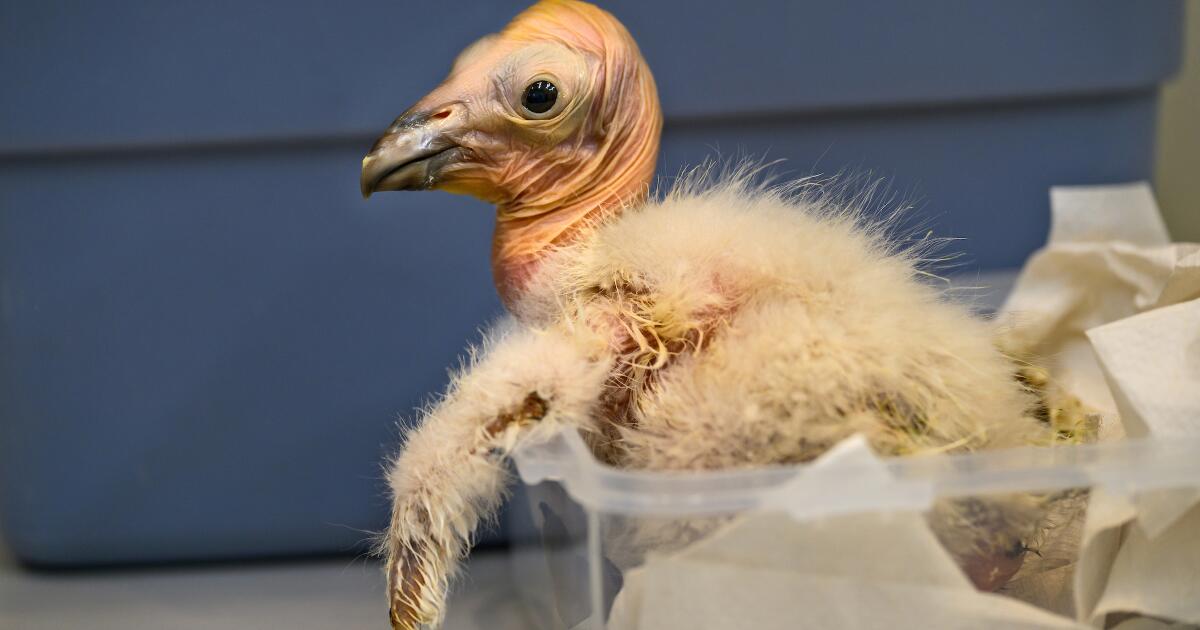Science
Deadly overdoses fell in U.S. for first time in five years, new estimates show

Deaths from drug overdoses fell last year in the United States as fewer people lost their lives to fentanyl and other opioids, marking the first time the death toll had dropped in five years, according to newly released estimates from the Centers for Disease Control and Prevention.
Federal officials said the numbers show a 3% decline in the estimated overdose fatalities between 2022 and 2023. That downturn equates to nearly 3,500 fewer deaths across the U.S. than the year before.
The new figures are tentative and could still be updated. Even a slight decline could be a balm for a country where drug overdoses have taken a devastating toll: In one survey, more than 40% of adults said they knew someone who lost their life to a drug overdose, according to a Rand study published this year.
“I’m thrilled that there wasn’t an increase, but we’re still talking about 107,000 people dying, which is completely unacceptable,” said Beau Kilmer, co-director of the Rand Drug Policy Research Center. Kilmer said better data on drug use are needed to untangle exactly what is driving the changes.
Community groups and health officials grappling with the devastating toll of fentanyl have pushed to equip more people with naloxone, a medicine that can stop opioid overdoses and is commonly sold as a nasal spray under the brand name Narcan. Los Angeles County officials, for instance, credited an effort to hand out Narcan on the streets when they announced last week that overdose deaths had stopped surging among homeless people. To try to reduce the deadly risks, people who use drugs have also turned to test strips to detect fentanyl and avoided using drugs by themselves, among other strategies.
Health researchers have also noted that broader changes in the population could be affecting the numbers: Many heroin users who switched to fentanyl have died, and if fewer people are newly turning to fentanyl use, that could mean fewer people are now at risk, said Dr. Daniel Ciccarone, a UCSF addiction medicine professor.
“Based on utterly anecdotal, street-level observations, I’ll say there aren’t a lot of newbies,” Ciccarone said. “We’re looking for them, but we don’t see them. We don’t see the 22-year-old who says, ‘Hey, I want to use fentanyl.’ This is an aging cohort.”
Even as U.S. deaths linked to fentanyl and other opioids dropped between 2022 and 2023, the country saw an uptick in deaths tied to stimulants such as methamphetamine and cocaine, according to the new estimates. Drug researchers said that in recent years, many deaths involving meth have also involved opioids.
And not all parts of the country saw an overall drop in fatal overdoses. “In the East Coast and in the Midwest, we are seeing declines, but on the West Coast — particularly in the upper Northwest — we’re still seeing increases,” said Farida Ahmad, a health scientist at the National Center for Health Statistics.
The federal figures show that in California, the estimated number of overdose deaths continued to rise in 2023 compared with 2022, increasing by 4.1%. In Oregon and Washington, increases were significantly steeper — roughly 30% and 27% respectively.
Drug use can differ from region to region, shaping ensuing overdoses and deaths: Fentanyl hit the eastern U.S. before spreading west, and methamphetamine use generally has been more common on the West Coast.
Ciccarone lamented that the West Coast should have been better prepared for fentanyl after seeing it hit other parts of the country years earlier, calling it a “failure of public policy.”
“We saw this coming. So why didn’t we prepare for it better?”
Ciccarone credited states in the Midwest and East Coast that had seen notable decreases in overdose deaths, saying that although the exact reasons are unclear, there has been a panoply of efforts that could play a role, including ramping up naloxone distribution and easing access to buprenorphine to treat opioid addiction.
“These are places that were hard hit by fentanyl,” Ciccarone said. “So they’re doing something right.”
The federal estimates released Wednesday do not detail how many deaths linked to methamphetamine also involved other drugs, a phenomenon that has gained growing attention as American mix drugs both knowingly and unknowingly.
Researchers drawing on both federal and local data have found substantial overlap in methamphetamine and opioid use: In L.A. County, for instance, a recent report indicated that in 2022, nearly half of overdose deaths among homeless people involved both methamphetamine and fentanyl.
People who use fentanyl may turn to stimulants for energy to get themselves through daily activities, said Chelsea Shover, an assistant professor at UCLA’s David Geffen School of Medicine. For those facing the dangers of living outside, “you know what helps you stay up at night and stay vigilant? Meth.”
Shover said in recent years, national data have consistently shown the majority of methamphetamine deaths also involve opioids. Those findings were echoed in local research by Shover and other researchers, which found that between 2012 and mid-2021, the bulk of meth-related deaths in L.A. County also involved other drugs or medical conditions, rather than being driven solely by the stimulant.
To help prevent such deaths, “we need to keep doing what we’re doing for opioid-related deaths — because a lot of meth-involved deaths are also opioid-involved,” Shover said.
Scholars have also urged more attention to methamphetamine itself: As it stands, there are no medications approved by the Food and Drug Administration to treat addiction to meth, although some existing medicines have shown promising results, as has offering incentives such as gift cards for people to stay off stimulants.
“The massive investment in reducing overdose deaths has been almost exclusively targeted to opioids,” said Steven Shoptaw, director of the UCLA Center for Behavioral and Addiction Medicine. “There’s been no systematic investment to reduce methamphetamine deaths” — a lapse that Shoptaw said had hindered effective interventions from being widely adopted.
Americans have been eager for any signs of hope amid the overdose crisis, but experts have cautioned against declaring victory too soon in reaction to year-to-year changes in overdose deaths.
For instance, University of Pittsburgh researchers found that the last time fatal overdoses dropped nationally in 2018, the downturn coincided with stricter regulations in China on carfentanil, a highly potent synthetic opioid. The following year, deaths from drug overdoses rose again.
Dr. Donald Burke said that the estimated number of overdose deaths in 2023 was still above the level that researchers had forecast, based on the historic trajectory of such fatalities. The death numbers had jumped higher than expected during the COVID-19 pandemic, Burke said — and may just be returning to the same levels that would have happened in its absence.
“You can make a case that it’s come down, but it’s come down because the COVID impact is less now,” said Burke, dean emeritus of the University of Pittsburgh School of Public Health.
“Without knowing what are the drivers, it’s really hard to tell whether a reduction is a return to the expected trajectory or some other change,” said Dr. Hawre Jalal, an associate professor at the University of Ottawa who has partnered with Burke on such research.
Ciccarone was reluctant to even characterize the newly released estimates as a decrease in overdose deaths, instead referring to “a flattening of the curve.”
“Can we sing hosannas over that? No,” Ciccarone said. “We’re still fighting. We still have a lot of work to do to bend this overdose curve down.”

Science
Q&A: Learn how Olympians keep their cool from Team USA's chief sports psychologist

Your morning jog or weekly basketball game may not take place on an Olympic stage, but you can use Team USA’s techniques to get the most out of your exercise routine.
It’s not all about strength and speed. Mental fitness can be just as important as physical fitness.
That’s why the U.S. Olympic & Paralympic Committee created a psychological services squad to support the mental health and mental performance of athletes representing the Stars and Stripes.
“I think happy, healthy athletes are going to perform at their best, so that’s what we’re striving for,” said Jessica Bartley, senior director of the 15-member unit.
Bartley studied sports psychology and mental health after an injury ended her soccer career. She joined the USOPC in 2020 and is now in Paris with Team USA’s 592 competitors, who range in age from 16 to 59.
Bartley spoke with The Times about how her crew keeps Olympic athletes in top psychological shape, and what the rest of us can learn from them. Her comments have been edited for length and clarity.
Why is exercise good for mental health?
It gets you moving. It gets the endorphins going. And there’s often a lot of social aspects that are really helpful.
There are a number of sports that stretch your brain in ways that can be really, really valuable. You’re thinking about hand-eye coordination, or you’re thinking about strategy. It can improve memory, concentration, even critical thinking.
What’s the best way to get in the zone when it’s time to compete?
When I work with athletes, I like to understand what their zone is. If a 0 or a 1 is you’re totally chilled out and a 10 is you’re jumping around, where do you need to be? What’s your number?
People will say, “I’m at a 10 and I need to be at an 8 or a 7.” So we’ll talk about ways of bringing it down, whether it’s taking a deep breath, listening to relaxing music, or talking to your coach. Or there’s times when people say they need to be more amped up. That’s when you see somebody hitting their chest, or jumping up and down.
If you make a mistake in the middle of a competition, how do you move on instead of dwelling on it?
I often teach athletes a reset routine. I played goalie, so I had a lot of time to think after getting scored on. I would undo my goalie gloves and put them back on, which to me was a reset. I would also wear an extra hairband on my wrist, and when I would snap it, that meant I needed to get out of my head.
It’s not just a physical reset — it helps with a mental reset. If you do the same thing every single time, it goes through the same neural pathway to where it’s going to reset the brain. That can be really impactful.
Do Olympic athletes have to deal with burnout?
Oh, yeah. Everybody has a day where they don’t want to do whatever it is. That’s when you have to ask, “What’s in my best interests? Do I need a recovery day, or do I really need to get in the pool, or get in the gym?”
Sometimes you really do need what we like to refer to as a mental health day.
How can you psych yourself up for a workout when you just aren’t feeling it?
It’s really helpful to think about why you’re doing this and why you’re pushing yourself. Do you have goals related to an activity or sport? Is there something tied to values around hard work or discipline, loyalty or dependability?
When you don’t want to get in the gym, when you don’t want to go for a run, think about something bigger. Tie it back to values.
Is sleep important for maintaining mental health?
Yes! We started doing mental health screens with athletes before the Tokyo Games. We asked about depression, anxiety, disordered eating and body image, drugs and alcohol, and sleep. Sleep was actually our No. 1 issue. It’s been a huge initiative for us.
How much sleep should we be getting?
It’s different for everyone, but generally we know seven to nine hours of sleep is good. Sometimes some of these athletes need 10 hours.
I highly recommend as much sleep as you need. If you didn’t get enough sleep, napping can be really valuable.
Is napping just for Olympic athletes or is it good for everybody?
Everybody! Naps are amazing.
What if there’s no time for a nap?
There are different ways of recharging. Naps could be one of them, but maybe you just need to get off your feet for 20 minutes. Maybe you need to do a meditation or mindfulness exercise and just close your eyes for five minutes.
How do you minimize the effects of jet lag?
We try to shift one hour per day. That’s the standard way of doing it. If you can, it’s super helpful. But it’s not always possible.
The thing we tell athletes is that our bodies are incredible, and you will even things out if you can get back on schedule. One or two nights of crummy sleep is not going to impact your overall performance.
What advice do you give athletes who have trouble falling asleep the night before a competition?
You don’t want to change much right before a competition, so I usually direct athletes to do what they would normally do.
Do you need to unwind by reading a book? Do you need to talk on the phone with somebody and get your mind off things? Can you put your mind in a really restful place and think about things that are really relaxing?
Are there any mindfulness or meditation exercises that you find helpful?
There are some athletes who benefit greatly from an hourlong meditation. I love something quick, something to reset my brain, maybe close my eyes for a minute.
If I’m feeling like I need to take a moment, I love mindful eating. You savor a bite and go, “Oh, my gosh, I have not been fully engaged with my senses today.” Or you could take a mindful walk and take in the sights, the smells, all of the things that are around you.
What do you eat when you need a quick nutrition boost?
Cashews. I tend to carry those with me. They’ve got enough energy to make sure I keep going, physically.
I’ve always got gummy bears on me too. There’s no nutritional value but they keep me going mentally. I’m a big proponent of both.
Is it OK to be superstitious in sports?
It depends how flexible you are. Maybe you put on your socks or shoes a certain way, or listen to certain music. Routines are really soothing. They set your brain up for success in a particular performance. It can be really, really helpful.
But I’ve also seen an athlete forget their lucky underwear or their lucky socks, and they’re all out of sorts. So your routine has to be flexible enough that you’re not going to completely fall apart if you don’t do it exactly.
Are Olympians made of stronger psychological stuff than the rest of us?
Not necessarily. There are some who don’t get feathers ruffled and have a high tolerance for the fanfare. There’s also a lot of regular human beings who just happen to be fantastic at a particular activity.
Science
‘Ready, Steady, Slow’: Championship Snail Racing at 0.006 M.P.H.

Earlier this month, the rural village of Congham, England, played host to a less likely group of athletes: dozens of garden snails. They had gathered to compete in the World Snail Racing Championships, where the world record time for completing the 13.5 inch course stands at 2 minutes flat. At that speed — roughly 0.006 miles per hour — it would take the snails more than six days to travel a mile.
Science
Caring for condor triplets! Record 17 chicks thrive at L.A. Zoo under surrogacy method

A new method of rearing California condors at the Los Angeles Zoo has resulted in a record-breaking 17 chicks hatched this year, the zoo announced Wednesday.
All of the newborn birds will eventually be considered for release into the wild under the U.S. Fish and Wildlife Service’s California Condor Recovery Program, a zoo spokesperson said.
“What we are seeing now are the benefits of new breeding and rearing techniques developed and implemented by our team,” zoo bird curator Rose Legato said in a statement. “The result is more condor chicks in the program and ultimately more condors in the wild.”
Breeding pairs of California condors live at the zoo in structures the staff “affectionately calls condor-miniums,” spokesperson Carl Myers said. When a female produces a fertilized egg, the egg is moved to an incubator. As its hatching approaches, the egg is placed with a surrogate parent capable of rearing the chick.
California condor eggs are cared for at L.A. Zoo. The animal is critically endangered.
(Jamie Pham / L.A. Zoo)
This bumper year of condor babies is the result of a modification to a rearing technique pioneered at the L.A. Zoo.
Previously, when the zoo found itself with more fertilized eggs than surrogate adults available, staff raised the young birds by hand. But condors raised by human caretakers have a lower chance of survival in the wild (hence the condor puppets that zookeepers used in the 1980s to prevent young birds from imprinting on human caregivers).
In 2017, the L.A. Zoo experimented with giving an adult bird named Anyapa two eggs instead of one. The gamble was a success. Both birds were successfully released into the wild.
Faced with a large number of eggs this year, “the keepers thought, ‘Let’s try three,’” Myers said. “And it worked.”
The zoo’s condor mentors this season ultimately were able to rear three single chicks, eight chicks in double broods and six chicks in triple broods. The previous record number of 15 chicks was set in 1997.
Condor experts applauded the new strategy.
“Condors are social animals and we are learning more every year about their social dynamics. So I’m not surprised that these chick-rearing techniques are paying off,” said Jonathan C. Hall, a wildlife ecologist at Eastern Michigan University. “I would expect chicks raised this way to do well in the wild.”
The largest land bird in North America with an impressive wingspan up to 9½ feet, the California condor could once be found across the continent. Its numbers began to decline in the 19th century as human settlers with modern weapons moved into the birds’ territory. The scavenger species was both hunted by humans and inadvertently poisoned by lead bullet fragments embedded in carcasses it ate. The federal government listed the birds as an endangered species in 1967.

A condor, one of a record-breaking 17 at the zoo, makes its way out of its shell.
(Jamie Pham / L.A. Zoo)
When the California Condor Recovery Program began four decades ago, there were only 22 California condors left on Earth. As of December, there were 561 living individuals, with 344 of those in the wild. Despite the program’s success in raising the population’s numbers, the species remains critically endangered.
In addition to the ongoing threat of lead poisoning, the large birds are also at risk from other toxins. One 2022 study found more than 40 DDT-related compounds in the blood of wild California condors — chemicals that had made their way from contaminated marine life to the top of the food chain.
“Despite our success in returning condors to the wild, free-flying condors continue to face many obstacles with lead poisoning being the No. 1 cause of mortality,” said Joanna Gilkeson, spokesperson for Fish and Wildlife’s Pacific Southwest Region. “Innovative strategies, like those the L.A. Zoo is implementing, help us to produce more healthy chicks and continue releasing condors into the wild.”
The chicks will remain in the zoo’s care for the next year and a half before they are evaluated for potential release to the wild. Thus far, the zoo has contributed 250 condor chicks to Fish and Wildlife’s program, some of which the agency has redeployed to other zoos as part of its conservation efforts.
In a paper published earlier this year, a team of researchers found that birds born in captivity have slightly lower survival rates for their first year or two but then have equally successful outcomes to wild-hatched birds.
“Because condors reproduce slowly, releases of captive-bred birds are essential to the recovery of the species, especially in light of ongoing losses due to lead-related mortality,” said Victoria Bakker, a quantitative ecologist at Montana State University and lead author of the paper. “The team at the L.A. Zoo should be recognized for their innovative and important contributions to condor recovery.”
-

 World1 week ago
World1 week agoOne dead after car crashes into restaurant in Paris
-

 Midwest1 week ago
Midwest1 week agoMichigan rep posts video response to Stephen Colbert's joke about his RNC speech: 'Touché'
-

 News1 week ago
News1 week agoVideo: Young Republicans on Why Their Party Isn’t Reaching Gen Z (And What They Can Do About It)
-

 Movie Reviews1 week ago
Movie Reviews1 week agoMovie Review: A new generation drives into the storm in rousing ‘Twisters’
-

 News1 week ago
News1 week agoIn Milwaukee, Black Voters Struggle to Find a Home With Either Party
-

 Politics1 week ago
Politics1 week agoFox News Politics: The Call is Coming from Inside the House
-

 News1 week ago
News1 week agoVideo: J.D. Vance Accepts Vice-Presidential Nomination
-

 World1 week ago
World1 week agoTrump to take RNC stage for first speech since assassination attempt















